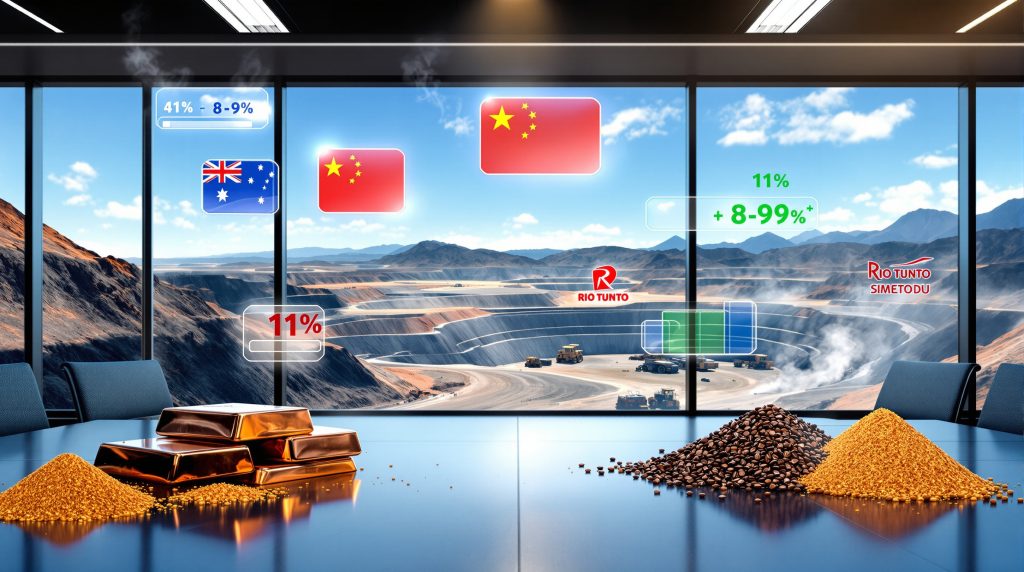Strategic Context Behind the Partnership
Rio Tinto's complex relationship with China's Aluminium Corporation of China Limited (Chinalco) traces back to the 2008 global financial crisis, when the Chinese state-owned enterprise acquired nearly 15% of Rio Tinto's London-listed shares. This investment came with significant strings attached, including Australian government-imposed restrictions that prevented Chinalco from increasing its stake without approval or securing board representation.
The partnership has created a strategic paradox for over 15 years. While Chinalco's investment provided crucial capital during Rio Tinto's period of financial stress, it simultaneously created governance constraints that have limited the Anglo-Australian miner's operational flexibility. The relationship became even more complicated in 2009 when Chinalco proposed a substantial $19.5 billion investment to help reduce Rio Tinto's then-massive $39 billion debt burden. This proposal was ultimately blocked by shareholders and regulators concerned about Chinese control over strategic mining assets.
Today, Chinalco holds approximately 11% of the overall dual-listed company, making it Rio Tinto's largest single shareholder. This position has effectively prevented Rio Tinto from executing large-scale share buyback programs and pursuing major merger opportunities without navigating complex regulatory approvals across multiple jurisdictions.
Transforming Ownership Structure Through Strategic Exchange
The proposed rio tinto asset-for-equity swap with chinalco represents a sophisticated approach to corporate restructuring that could benefit both parties while addressing longstanding governance challenges. Industry sources suggest the transaction would reduce Chinalco's shareholding by approximately 2 to 3 percentage points, bringing their stake down from roughly 11% to around 8-9%.
This reduction would unlock significant strategic flexibility for Rio Tinto's management team. The company would regain the ability to implement substantial capital return programs, including share buybacks that have been effectively suspended due to the complexities of diluting a major state-owned shareholder. Additionally, the restructured ownership would simplify merger and acquisition processes, allowing Rio Tinto to pursue strategic opportunities without requiring extensive regulatory approvals related to Chinese state involvement.
For Chinalco, the exchange offers direct operational involvement in key mining assets rather than passive equity ownership. This shift aligns with China's broader critical minerals strategy as global supply chains face increasing geopolitical scrutiny.
The mechanics of such a transaction would involve Chinalco exchanging a portion of its Rio Tinto shares for direct partnerships or increased stakes in specific mining operations. Furthermore, this approach maintains the strategic relationship while addressing the governance constraints that have hampered both companies' strategic options.
High-Value Assets Under Consideration
Simandou Iron Ore Project, Guinea
The massive Simandou iron ore deposit stands as one of the most likely assets to feature in any potential swap arrangement. This world-class project, already 75% Chinese-owned through various partnerships, represents a strategic prize that Chinalco previously attempted to acquire outright in a failed 2016 buyout bid.
Simandou's appeal extends beyond its substantial mineral endowment. The project offers China enhanced security over iron ore supplies, which remain critical to the country's steel production infrastructure. For instance, current iron ore demand insights suggest continued strong Chinese consumption patterns that make strategic asset control increasingly valuable.
Oyu Tolgoi Copper Mine, Mongolia
Located in Mongolia's South Gobi region, the Oyu Tolgoi copper-gold mine presents another compelling asset for potential inclusion in the swap. The operation's proximity to China, combined with copper's critical role in renewable energy infrastructure development, makes it strategically valuable for Chinese industrial planning.
The mine's underground expansion project represents one of the world's largest copper development initiatives. China's growing demand for copper, driven by electric vehicle production and renewable energy installations, creates natural synergies between Chinalco's strategic objectives and Oyu Tolgoi's production profile. However, the copper price outlook remains a key consideration for valuation purposes.
Titanium Business Operations
Rio Tinto's titanium business unit has emerged as another potential component of the asset exchange. China has systematically expanded its titanium dioxide production capabilities over the past decade, now controlling over half of global market output. This mineral finds applications across diverse industries, from paints and cosmetics to military hardware manufacturing.
The titanium business currently operates under strategic review as part of CEO Simon Trott's broader restructuring initiative. Consequently, including these operations in the Chinalco swap would align with China's existing market dominance while allowing Rio Tinto to focus resources on its core mining operations.
Mutual Benefits of Strategic Restructuring
| Rio Tinto Advantages | Chinalco Strategic Gains |
|---|---|
| Restored buyback flexibility | Direct asset control |
| Simplified M&A processes | Enhanced supply security |
| Reduced regulatory complexity | Operational involvement |
| Enhanced capital allocation | Strategic resource access |
The restructuring addresses specific pain points for both organisations. Rio Tinto gains the operational flexibility that activist investors have demanded, particularly regarding the dual Anglo-Australian listing structure that complicates strategic decision-making. The company would be positioned to participate more actively in the mining sector's ongoing consolidation wave.
For Chinalco, the benefits centre on transitioning from passive financial investment to active resource participation. Direct asset involvement provides greater supply chain integration opportunities and reduces exposure to potential future restrictions on Chinese equity holdings in strategic Western companies.
In addition, the timing aligns with broader industry trends where mining companies seek to attract investors focused on long-term supply prospects through consolidation and strategic partnerships. This approach has become increasingly important as governments worldwide scrutinise foreign investments in critical mineral sectors.
What Regulatory Challenges Must Be Overcome?
The current governance structure reflects the complex regulatory environment surrounding Chinese investments in strategic Australian resources. When Chinalco made its initial investment in 2008, the Australian government imposed specific conditions designed to balance foreign investment benefits with national security considerations.
These restrictions have created ongoing complications for Rio Tinto's strategic planning. The dual-listing structure across London and Australian stock exchanges adds additional complexity, as different regulatory frameworks apply to various corporate actions. Activist investors have increasingly criticised this arrangement, arguing it creates conflicts between UK and Australian shareholders while limiting strategic flexibility.
The 2009 proposed investment failure illustrates the challenges of expanding Chinese involvement in Australian mining assets. Despite offering substantial capital to address Rio Tinto's debt situation, regulatory and shareholder concerns about strategic asset control ultimately blocked the transaction.
However, current regulatory trends suggest similar constraints would apply to any direct stake increases by Chinalco. Nevertheless, asset-for-equity swaps may face different regulatory treatment, particularly when they result in reduced rather than increased Chinese ownership percentages in the parent company.
Timeline and Implementation Considerations
Industry sources indicate Rio Tinto may provide strategic updates within the coming weeks, potentially ahead of the company's scheduled December 4, 2025 investor day. This timeline aligns with CEO Simon Trott's broader reorganisation efforts, which began shortly after he assumed leadership on August 25, 2025.
Trott has already demonstrated commitment to structural changes, reducing the executive committee from 11 to 9 members and announcing plans to streamline business operations from four core units to three. These organisational changes create a framework for more significant strategic restructuring, including potential asset exchanges.
Furthermore, the timing reflects practical considerations around market conditions and regulatory approval processes. Recent Bloomberg coverage suggests extensive due diligence on asset valuations and operational transitions is already underway.
Any formal announcement would likely include detailed implementation phases, regulatory approval timelines, and specific asset transition procedures. The complexity suggests actual completion could extend well into 2026, assuming all parties reach agreement on transaction terms.
How Does This Fit Broader Strategic Reorganisation?
Beyond the potential Chinalco arrangement, Rio Tinto is pursuing comprehensive strategic restructuring under Trott's leadership. The company has initiated reviews of its borates, iron ore optimisation opportunities, and titanium operations as part of a broader focus on profitable asset allocation.
Jadar Lithium Project Uncertainty
The Jadar lithium project in Serbia faces particular scrutiny despite its strategic importance to European Union battery supply chain security. Environmental opposition groups have mounted sustained campaigns against the development, creating political complications that may influence Rio Tinto's continued commitment to the project.
Sources suggest the company is considering pausing early development work, which would represent a significant strategic shift given lithium's critical role in global energy transition initiatives. This decision reflects the complex balance between resource development opportunities and operational risk management.
Organisational Efficiency Measures
The restructuring extends to organisational design, with managing director positions expected to decrease as part of the streamlining initiative. Rather than imposing company-wide cost reduction targets, Trott has requested department-specific efficiency plans, suggesting a more targeted approach to operational optimisation.
These changes reflect broader mining industry evolution toward leaner organisational structures and focused asset portfolios. Companies are increasingly prioritising operational excellence in core competency areas rather than maintaining diversified portfolios across multiple mineral categories.
Industry Context and Competitive Dynamics
The potential rio tinto asset-for-equity swap with chinalco occurs within a rapidly evolving global mining landscape characterised by increasing consolidation activity and heightened geopolitical scrutiny of critical mineral supply chains.
Western governments have intensified focus on reducing dependence on Chinese-controlled mineral processing and refining capabilities, particularly for materials essential to renewable energy and defence applications. This policy environment creates both opportunities and constraints for mining companies with significant Chinese partnerships.
Critical Mineral Supply Security
China's dominance across multiple critical mineral supply chains has prompted strategic responses from the United States, European Union, and allied nations. These initiatives include domestic processing capability development, alternative supply source identification, and restrictions on certain types of foreign investments in strategic sectors.
The mining industry has responded by pursuing strategic partnerships that balance access to Chinese markets and capital with Western regulatory requirements. Asset-for-equity arrangements represent one mechanism for maintaining productive relationships while addressing government concerns about strategic asset control.
What's Driving the Consolidation Wave?
Mining sector consolidation continues accelerating as companies seek to:
- Secure long-term supply prospects for high-demand minerals
- Achieve operational efficiencies through increased scale
- Attract institutional investors focused on resource security themes
- Optimise capital allocation across focused asset portfolios
- Navigate complex geopolitical and regulatory environments
This environment favours companies with operational flexibility and clear strategic focus, making Rio Tinto's governance restructuring particularly timely from a competitive positioning perspective.
Market Response Expectations
Historical precedent suggests that successful resolution of longstanding governance constraints typically generates positive investor sentiment in the mining sector. Companies that enhance strategic flexibility while maintaining valuable partnerships often experience improved valuation multiples and increased institutional investor interest.
Capital Allocation Impact
The restoration of share buyback capabilities would provide Rio Tinto with enhanced tools for capital return optimisation. Mining companies with flexible capital allocation frameworks generally command premium valuations during strong commodity price environments, as investors value the ability to participate in exceptional cash flow generation.
Enhanced merger and acquisition flexibility could position Rio Tinto more competitively in potential consolidation opportunities. The mining sector's fragmented structure creates ongoing opportunities for value-creating combinations, particularly in high-demand mineral categories.
Commodity Market Considerations
Direct Chinese involvement in specific Rio Tinto assets could influence supply agreement structures and pricing mechanisms, particularly for iron ore and copper markets. However, the overall impact would likely depend on specific operational arrangements rather than ownership changes alone.
The titanium market could experience more direct effects if that business unit transitions to Chinese ownership, given China's existing market dominance and potential for further industry consolidation. Additionally, US-China trade impacts on mineral commodity flows remain an important consideration for market participants.
Navigating Complex Approval Processes
Any asset-for-equity transaction between Rio Tinto and Chinalco would require navigating multiple regulatory frameworks across several jurisdictions. The complexity reflects both companies' global operations and the strategic nature of the assets under consideration.
Australian Regulatory Requirements
The Foreign Investment Review Board (FIRB) would likely need to evaluate any changes to Chinese involvement in Australian mining assets, even when overall Chinese ownership in Rio Tinto decreases. Recent policy changes have increased scrutiny of foreign investments in critical mineral sectors.
Host Country Considerations
Assets located in Guinea (Simandou) and Mongolia (Oyu Tolgoi) would require approvals from respective host country governments. These jurisdictions have their own policies regarding foreign ownership changes in major mining projects, often including local content and development requirements.
UK Regulatory Framework
Rio Tinto's London listing subjects the company to UK takeover and strategic investment regulations. While the proposed transaction differs from a traditional acquisition, it could still trigger review requirements depending on specific asset values and strategic significance determinations.
The approval process timeline would likely extend several months, requiring extensive documentation and potentially triggering public consultation periods in some jurisdictions.
Strategic Precedents and Innovation
The proposed rio tinto asset-for-equity swap with chinalco represents an innovative approach to resolving foreign ownership constraints while maintaining strategic partnerships. Few direct precedents exist in the mining sector, making this potentially precedent-setting for other companies facing similar governance challenges.
Alternative to Direct Divestment
Traditional approaches to reducing foreign ownership typically involve direct share sales or forced divestments, often at suboptimal valuations. The asset-for-equity model preserves value for both parties while addressing regulatory and strategic concerns.
This structure could influence how other mining companies approach similar challenges, particularly those with significant state-owned enterprise shareholders from countries facing increased Western regulatory scrutiny. MiningMX reports suggest several other major mining companies are monitoring this transaction structure for potential application to their own partnerships.
Balancing Commercial and Geopolitical Interests
The transaction structure demonstrates potential pathways for maintaining productive international business relationships within evolving geopolitical frameworks. Rather than severing ties entirely, both companies appear committed to restructuring their relationship to accommodate changing regulatory environments.
This approach may become increasingly relevant as governments worldwide seek to balance foreign investment benefits with strategic asset security concerns. For instance, the structure could provide a template for addressing similar ownership challenges across various critical mineral sectors.
Future Implications for Mining Partnerships
The rio tinto asset-for-equity swap with chinalco could establish important precedents for international mining partnerships operating under increasing geopolitical pressure. Success in this restructuring may encourage other companies to explore similar arrangements rather than pursuing complete divestments.
The transaction's outcome will likely influence how both Western mining companies and Chinese state-owned enterprises structure future strategic partnerships. Regulatory authorities across multiple jurisdictions will be closely monitoring the approval process and implementation details.
Furthermore, the arrangement demonstrates potential pathways for maintaining mutually beneficial commercial relationships despite evolving government policies on foreign investment in strategic sectors. This balance between commercial interests and national security considerations represents a key challenge for the global mining industry.
Disclaimer: This analysis is based on publicly available information and industry sources as reported by Reuters. Market implications and regulatory outcomes remain subject to numerous variables and should not be considered investment advice. Readers should consult with qualified financial advisors before making investment decisions related to Rio Tinto or other mining sector securities.
Looking to Capitalise on Mining Sector Restructuring?
Discovery Alert's proprietary Discovery IQ model delivers real-time alerts on significant ASX mineral discoveries, helping subscribers identify actionable opportunities as major mining companies navigate complex strategic changes. Visit Discovery Alert's discoveries page to see how historic mineral discoveries have generated substantial returns, then begin your 30-day free trial to position yourself ahead of market-moving announcements.




